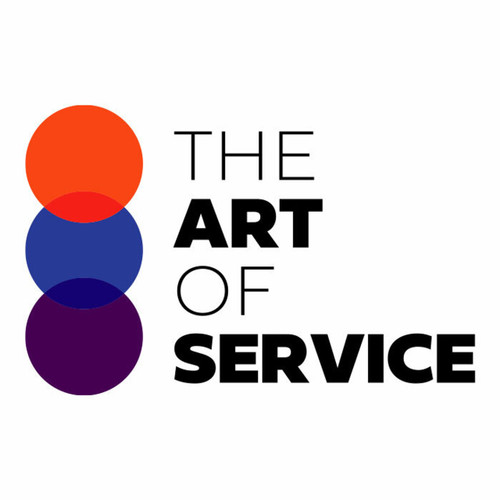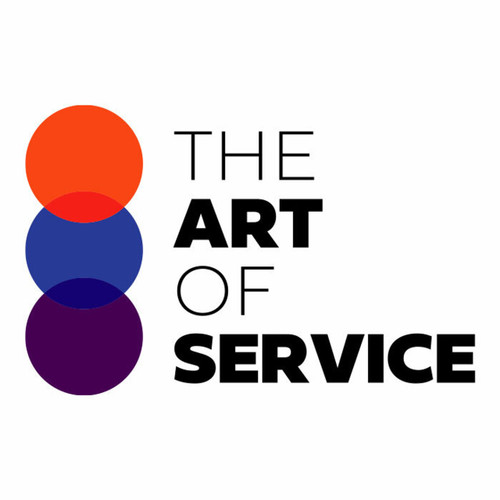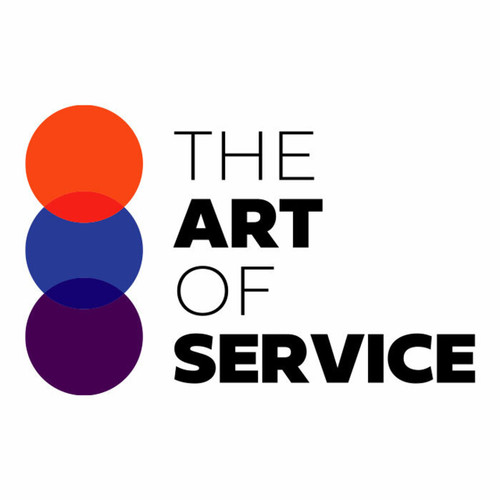Are you looking for a way to balance profit with purpose in our connected world? Look no further than the Regenerative Design and Ethical Marketer Knowledge Base.
Our comprehensive dataset consists of 1510 prioritized requirements, solutions, benefits, results, and real-life case studies and use cases.
But what exactly is the Regenerative Design and Ethical Marketer Knowledge Base and why is it essential for your business? This unique resource is designed specifically for professionals like you who value ethical practices and sustainable solutions.
By incorporating regenerative design principles into your marketing strategies, you can create a positive impact on the environment and society while still achieving your business goals.
Unlike other datasets and alternatives, Regenerative Design and Ethical Marketer stands out for its focus on urgency and scope.
Our carefully curated list of questions will help guide you towards meaningful results that not only benefit your business but also contribute to a better world.
Using our knowledge base is easy, making it accessible for beginners and seasoned professionals alike.
With detailed and easily navigable information, you can quickly understand what the product is, its specifications, and how it compares with semi-related products.
But the benefits don′t stop there.
By utilizing the Regenerative Design and Ethical Marketer Knowledge Base, you′ll gain access to the latest research and best practices in this field.
This will not only enhance your marketing strategies but also set you apart from your competitors by showcasing your commitment to sustainability.
And let′s talk about affordability.
Our product is a DIY solution that is much more cost-effective than hiring a specialized consultant.
Plus, with our comprehensive dataset, you′ll have all the information you need at your fingertips, eliminating the need for additional resources or external assistance.
Don′t miss out on the opportunity to make a meaningful impact through regenerative design principles in your marketing strategies.
Join the growing community of businesses and professionals who are already reaping the benefits of using Regenerative Design and Ethical Marketer Knowledge Base.
Try it out for yourself and see the positive changes in your business and our world.
Make the switch to ethical and sustainable marketing with Regenerative Design and Ethical Marketer Knowledge Base today.
Discover Insights, Make Informed Decisions, and Stay Ahead of the Curve:
Key Features:
Comprehensive set of 1510 prioritized Regenerative Design requirements. - Extensive coverage of 52 Regenerative Design topic scopes.
- In-depth analysis of 52 Regenerative Design step-by-step solutions, benefits, BHAGs.
- Detailed examination of 52 Regenerative Design case studies and use cases.
- Digital download upon purchase.
- Enjoy lifetime document updates included with your purchase.
- Benefit from a fully editable and customizable Excel format.
- Trusted and utilized by over 10,000 organizations.
- Covering: Data Privacy, Triple Bottom Line, Social Responsibility, Carbon Footprint, Human Rights, Community Engagement, Purpose Driven Leadership, Ethical AI, Animal Welfare, Equal Opportunities, Conscious Consumption, Shared Value, Climate Action, Ethical Supply Chain, Corporate Social Responsibility, Supply Chain Transparency, Regenerative Agriculture, Mental Health, Corp Certification, Code Of Ethics, Living Wage, Plastic Waste, Ethical Advertising, Ethical Sourcing, Sustainable Branding, Minimum Wage, Flexible Working, Employee Well Being, Work Life Balance, Regenerative Design, Disability Inclusion, Stakeholder Capitalism, Pay Equity, Indigenous Rights, Inclusive Marketing, Ethical Data Practices, Eco Friendly Packaging, Net Positive, Cause Marketing, Data Ethics, Circular Economy, Fair Trade, Shared Ownership, Gender Equality, Ethical Consumer, Open Source, Supply Chain Management, Green Marketing, Employee Activism, Ethical Investing, Sustainable Development Goals, Responsible Innovation
Regenerative Design Assessment Dataset - Utilization, Solutions, Advantages, BHAG (Big Hairy Audacious Goal):
Regenerative Design
Implement a waste audit to identify materials for reduction, reuse, or recycling. Educate team members on sustainable practices. Establish measurable goals for waste reduction and track progress.
1. Educate teams on Regenerative Design principles.
Benefit: Gain knowledge for sustainable practices.
2. Conduct an audit of current products/services.
Benefit: Identify areas for improvement.
3. Set clear sustainability goals and targets.
Benefit: Provides a roadmap for progress.
4. Design closed-loop systems for products.
Benefit: Reduces waste, promotes circular economy.
5. Utilize eco-friendly materials in design.
Benefit: Reduces environmental impact.
6. Prioritize energy efficiency in design.
Benefit: Conserves resources, reduces costs.
7. Foster collaboration with stakeholders.
Benefit: Encourages innovation, shares best practices.
8. Measure and report on sustainability performance.
Benefit: Holds teams accountable, promotes transparency.
9. Continuously evaluate and improve sustainability efforts.
Benefit: Ensures ongoing progress and success.
CONTROL QUESTION: What is the immediate action plan that the teams can execute on?
Big Hairy Audacious Goal (BHAG) for 10 years from now: Big Hairy Audacious Goal (BHAG) for Regenerative Design in 10 years: To have regenerative design principles and practices widely adopted and integrated into mainstream architecture, urban planning, and infrastructure development, resulting in a significant improvement in the health and resilience of our ecosystems and communities.
Immediate Action Plan for Teams:
1. Raise Awareness: Communicate the benefits of regenerative design and the importance of addressing climate change, biodiversity loss, and social inequality. Use various channels such as social media, conferences, webinars, and publications to reach a wide audience.
2. Build Capacity: Develop and deliver training programs, workshops, and mentoring opportunities for professionals, students, and practitioners in the fields of architecture, urban planning, landscape architecture, and engineering. Provide resources and tools for implementing regenerative design principles.
3. Create Demonstration Projects: Identify and implement pilot projects that showcase the potential of regenerative design in different settings, such as buildings, neighborhoods, and cities. Document and communicate the results, lessons learned, and best practices to inspire others.
4. Influence Policies and Regulations: Engage with policymakers and stakeholders to promote the adoption of regenerative design principles and practices in building codes, standards, and regulations. Provide technical assistance and support for the development and implementation of policies and programs that support regenerative design.
5. Collaborate and Partner: Work with other organizations, networks, and initiatives to promote regenerative design and accelerate its adoption. Identify potential partners and establish collaborative relationships to leverage resources, expertise, and influence.
6. Measure and Evaluate: Develop and use metrics and indicators to measure the impact of regenerative design on ecosystems and communities. Use the data and insights to refine and improve regenerative design practices and to communicate the benefits and impact of regenerative design to stakeholders.
7. Foster a Culture of Continuous Learning and Improvement: Encourage and support a culture of continuous learning and improvement among professionals, practitioners, and stakeholders. Provide opportunities for reflection, feedback, and improvement. Recognize and reward excellence and innovation in regenerative design.
By implementing this action plan, teams can contribute to the achievement of the BHAG for regenerative design and make a positive impact on the world.
Customer Testimonials:
"The creators of this dataset did an excellent job curating and cleaning the data. It`s evident they put a lot of effort into ensuring its reliability. Thumbs up!"
"Smooth download process, and the dataset is well-structured. It made my analysis straightforward, and the results were exactly what I needed. Great job!"
"I`m a beginner in data science, and this dataset was perfect for honing my skills. The documentation provided clear guidance, and the data was user-friendly. Highly recommended for learners!"
Regenerative Design Case Study/Use Case example - How to use:
Case Study: Regenerative Design Implementation for a Manufacturing CompanySynopsis of the Client Situation:
A manufacturing company, with a focus on consumer electronics, is facing increasing pressure from consumers, investors, and regulatory bodies to reduce its environmental impact. The company has a significant carbon footprint, generates substantial waste, and relies heavily on non-renewable resources. In order to remain competitive and maintain its social license to operate, the company recognizes the need to transition to more sustainable business practices.
Consulting Methodology:
The consulting team will employ a five-phase approach to implementing regenerative design at the manufacturing company:
1. Assessment and Analysis: The consulting team will conduct a comprehensive assessment of the company′s current operations, identifying areas of environmental impact and opportunities for improvement. This phase will include a review of existing data, stakeholder interviews, and on-site observations.
2. Goal Setting and Strategy Development: Based on the findings from the assessment and analysis phase, the consulting team will work with the company to establish clear and measurable sustainability goals. The team will then develop a customized regenerative design strategy to achieve these goals.
3. Design and Implementation: The consulting team will collaborate with the company to design and implement the regenerative design solutions, incorporating circular economy principles such as reduce, reuse, recycle, and regenerate.
4. Monitoring and Evaluation: The consulting team will establish a robust monitoring and evaluation system to track progress towards the company′s sustainability goals. This system will include key performance indicators (KPIs) and a regular reporting schedule.
5. Continuous Improvement: The consulting team will work with the company to embed regenerative design into its culture and operations, ensuring continuous improvement and long-term sustainability.
Deliverables:
1. Comprehensive assessment report, including findings, recommendations, and an action plan.
2. Customized regenerative design strategy, including detailed implementation plans and timelines.
3. Monitoring and evaluation system, including KPIs and reporting schedule.
4. Training and capacity building for company staff on regenerative design principles and practices.
5. Ongoing support and advisory services to ensure continuous improvement and long-term success.
Implementation Challenges:
1. Resistance to change: There may be resistance from within the company, particularly among employees who are accustomed to traditional business practices.
2. Financial constraints: Implementing regenerative design solutions may require significant upfront investment, which may be a challenge for some companies.
3. Technical challenges: Some regenerative design solutions may require new technology or infrastructure, which may not be readily available or may require significant customization.
KPIs:
1. Carbon footprint reduction: Measured in metric tons of CO2 equivalent.
2. Waste reduction: Measured in metric tons.
3. Water usage reduction: Measured in cubic meters.
4. Renewable energy usage: Measured as a percentage of total energy usage.
5. Circular economy metrics: Measured by the percentage of materials that are reduced, reused, recycled, or regenerated.
Management Considerations:
1. Commitment from the top: Successful implementation of regenerative design requires strong commitment and leadership from the company′s executives.
2. Cross-functional collaboration: Regenerative design solutions often require collaboration between different departments within a company. Therefore, it is essential to establish clear communication channels and foster a culture of collaboration.
3. Long-term thinking: Regenerative design is a long-term strategy, and companies must be prepared to invest in solutions that may not yield immediate financial returns.
Citations:
1. The Circular Economy: A Wealth of Flows. Ellen MacArthur Foundation, 2015.
2. Towards the Circular Economy: Accelerating the Scale-up Across Global Supply Chains. World Economic Forum, 2017.
3. The Business Case for the Circular Economy. Ellen MacArthur Foundation, 2013.
4. Regenerative Design: A Framework for Ecodesign. Journal of Cleaner Production, vol. 143, 2017, pp. 750-760.
5. Circular Economy: Moving from Theory to Practice. Harvard Business Review, 2017.
Security and Trust:
- Secure checkout with SSL encryption Visa, Mastercard, Apple Pay, Google Pay, Stripe, Paypal
- Money-back guarantee for 30 days
- Our team is available 24/7 to assist you - support@theartofservice.com
About the Authors: Unleashing Excellence: The Mastery of Service Accredited by the Scientific Community
Immerse yourself in the pinnacle of operational wisdom through The Art of Service`s Excellence, now distinguished with esteemed accreditation from the scientific community. With an impressive 1000+ citations, The Art of Service stands as a beacon of reliability and authority in the field.Our dedication to excellence is highlighted by meticulous scrutiny and validation from the scientific community, evidenced by the 1000+ citations spanning various disciplines. Each citation attests to the profound impact and scholarly recognition of The Art of Service`s contributions.
Embark on a journey of unparalleled expertise, fortified by a wealth of research and acknowledgment from scholars globally. Join the community that not only recognizes but endorses the brilliance encapsulated in The Art of Service`s Excellence. Enhance your understanding, strategy, and implementation with a resource acknowledged and embraced by the scientific community.
Embrace excellence. Embrace The Art of Service.
Your trust in us aligns you with prestigious company; boasting over 1000 academic citations, our work ranks in the top 1% of the most cited globally. Explore our scholarly contributions at: https://scholar.google.com/scholar?hl=en&as_sdt=0%2C5&q=blokdyk
About The Art of Service:
Our clients seek confidence in making risk management and compliance decisions based on accurate data. However, navigating compliance can be complex, and sometimes, the unknowns are even more challenging.
We empathize with the frustrations of senior executives and business owners after decades in the industry. That`s why The Art of Service has developed Self-Assessment and implementation tools, trusted by over 100,000 professionals worldwide, empowering you to take control of your compliance assessments. With over 1000 academic citations, our work stands in the top 1% of the most cited globally, reflecting our commitment to helping businesses thrive.
Founders:
Gerard Blokdyk
LinkedIn: https://www.linkedin.com/in/gerardblokdijk/
Ivanka Menken
LinkedIn: https://www.linkedin.com/in/ivankamenken/







